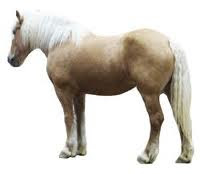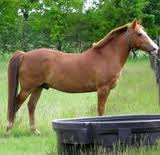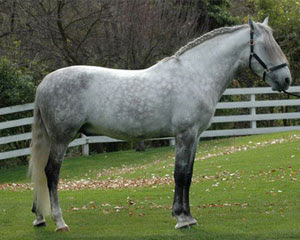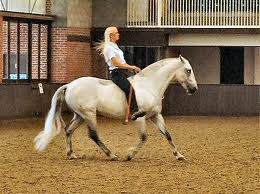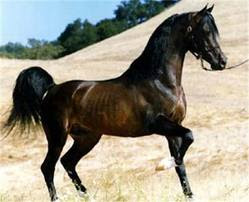Use Right now: The American Cream Draft along with other draft horses are still utilised for hobby farming, logging, driving and hay rides. Some are also ridden.
Color: All horses are cream colored with white manes and tails and other white markings, also as pink skin.
Height: 15.1 to 16.three hand
The American Cream Draft is actually a rare draft horse breed, the only such breed developed in the United States. It can be known for its cream color and amber eyes, produced by the champagne gene. The only other color found within the breed is chestnut, and the cream color produced by the champagne gene working on the chestnut base coat is identified as "gold champagne". Like various other breeds of draft horses, the American Cream is at risk for the autosomal recessive genetic disease junctional epidermolysis bullosa.
The breed developed in Iowa throughout the early 20th century, beginning with a cream-colored mare named "Old Granny". The Wonderful Depression threatened the breed's existence, but numerous breeders worked to strengthen the color and type of the breed and in 1944 a breed registry was formed. The mechanization of farming in the mid-20th century led to a decrease inside the breed's population along with the registry went inactive for several decades. It was reactivated in 1982 and population numbers have slowly grown considering that then. On the other hand, population numbers are still considered essential by both the American Livestock Breeds Conservancy and the Equus Surviva
American Cream Draft Horses Videos :
Characteristics
The breed has a refined head, with a profile that is neither concave or convex.They have a wide chest, sloping shoulders plus a short, powerful back. Their ribs are nicely sprung, and they are short-coupled with well-muscled hindquarters, great powerful legs set well apart and in proportion to their body. They are surefooted, with powerful hooves and their movement is no cost and simple.The breed is reputed to have a calm, willing temperament, particularly suited for owners who're new to handling draft horses.[3] Mares stand 15 to 16 hands (60 to 64 inches, 152 to 163 cm) high and weigh 1,500 to 1,600 pounds (680 to 730 kg), while stallions and geldings stand 16 to 16.three hands (64 to 67 inches, 163 to 170 cm) and weigh 1,800 pounds (820 kg) or far more.
The ideal color for the breed is actually a medium cream with pink skin, amber eyes plus a white mane and tail.The cream color of the breed is produced by the champagne gene (CH).Recognized colors include light, medium and dark cream, with amber or hazel eyes.A cream mare with dark skin as well as a light mane and tail could be accepted for "foundation stock," whilst stallions should have pink skin and white manes and tails to be registered.Purebred American Cream foals that are too dark are accepted into the principal breed registry may be recorded into an appendix registry.The appendix will also accept half-cream horses crossed with other draft bloodlines if they meet certain requirements, and the registry provides an upgrade system that uses appendix horses to strengthen genes, increase breed numbers,and allow additional diversified bloodlines.Dark-skinned American Cream Draft horses are actually chestnuts, as the breed just isn't homozygous for the champagne gene; only 1 allele is needed to generate the appropriate color. Champagne dilutes any base coat color, and within the American Cream Draft, the underlying genetic base color is chestnut. Based on existing information, breed also doesn't carry the cream gene, although breeders refer to the desired color as "cream".The American Cream Draft is never cremello or white and though the gold coat color having a white mane and tail resembles palomino, the breed's defining characteristics are the result of the champagne gene.
The autosomal recessive genetic disease junctional epidermolysis bullosa (JEB), has been found in some American Cream Drafts.This can be a lethal genetic disorder that causes newborn foals to lose big areas of skin and have other abnormalities, typically resulting in euthanasia. It is most generally associated with Belgian horses, but is also discovered in other draft breeds. A DNA test was developed in 2002, and foals affected by JEB might be avoided as long as two carriers aren't bred to 1 a different.The American Cream registry states that it has "been pro-active in testing its registered animals considering that JEB was discovered"
 |
| American Cream Draft |
Color genetics
The champagne gene produces diluted color, as well as the gold champagne body color, ivory mane and tail, light skin and light eyes associated with the American Cream Draft is produced by the action of the champagne gene on a chestnut base coat.In the adult horse, the skin is pink with abundant dark freckles or mottling, and the eyes are hazel or amber. The eyes of champagne Foals are blue at birth, darkening as they age, and a foal's skin is bright pink.The breed registry describes foals' eyes as "almost white," which is consistent with the nature of the champagne blue foal eye, which is creamier than other types of blue eye.
Champagne is actually a dominant trait, based on a mutation in the SLC36A1 gene.The mapping of the gene was announced in 2008, and an American Cream Draft Cross was one of the animals used to assist map the gene.The authors of this study noted that it was complicated to distinguish between homozygous and heterozygous animals, therefore distinguishing champagne from incomplete dominant dilutions such as the cream gene. Nonetheless they noted that homozygotes may well have much less mottling or a slightly lighter hair color than heterozygotes.Anecdotal reports also note mild but noticeable differences; the hair coat, skin, and freckling appear to be lighter, but the eye color is not.[
Breed history
The American Cream is the only breed of draft horse developed in the United States that's still in existence nowadays. The breed descends from a foundation mare named Old Granny. She was in all probability foaled between 1900 and 1905, and was 1st noticed at an auction in Story County, Iowa in 1911 and purchased by Harry Lakin, a well identified stock dealer.She was eventually sold to Nelson Brothers Farm in Jewell, Iowa. Her breeding just isn't identified, but she was cream-colored and many of her foals were also; they sold for above average costs due to this. Her cream-colored coat, pink skin and amber eyes are defining standards for the breed as well as the color is now known to be gold champagne. In 1946, two years after the breed registry was formed, 98 percent of the horses registered could be traced back to Old Granny.
In 1920, a colt of Old Granny's named Nelson's Buck No. two impressed veterinarian Eric Christian to the point that Christian asked the Nelsons not to geld him.They agreed to let him remain a stallion, and he sired numerous cream-colored foals, though only one was registered.This was a colt, named Yancy No. 3, and his dam was a black Percheron mare.Yancy sired Knox 1st, born in 1926 to a bay grade mare of Shire ancestry.From this sire line, in 1931, a great-great-grandson of Nelson's Buck was born, named Silver Lace No. 9. Silver Lace was to turn out to be 1 of the most influential stallions of the American Cream breed. His dam was a light chestnut Belgian mare, and she is credited with Silver Lace's size - at 2,230 pounds (1,010 kg) he weighed considerably extra than most of the other horses of his bloodline. Silver Lace rapidly became a common stallion in Iowa. However, stallions standing for public stud service in Iowa had been required to be registered with the Iowa Department of Agriculture, and this agency only registered horses of recognized breeds. As Silver Lace was not registered with any breed registry, his owners created a breeding syndicate, and mare owners who bought shares within the "Silver Lace Horse Company" could breed their mares to him. Even so, his most important breeding career coincided with the economic struggles of the Terrific Depression, and Silver Lace was at one point hidden in a neighbor's barn to stop him from being sold at auction. Yet another important foundation stallion was Ead’s Captain, whose bloodlines appear in about one-third of all American Cream Drafts.
Around 1935, even so, a few breeders were able to linebreed and inbreed cream-colored horses to fix their color and type.In particular, C.T. Rierson began purchasing cream-colored mares sired by Silver Lace and began creating the American Cream breed in earnest. In 1944, a breed association, the American Cream Association, was formed by 20 owners and breeders and granted a corporate charter in the state of Iowa. In 1950, the breed was lastly recognized by the Iowa Department of Agriculture, based on a 1948 recommendation by the National Stallion Enrollment Board.
The mechanization of farming inside the mid 20th century led to a decrease in the overall draft horse population, and with Rierson's death in 1957, numbers began to decline. By the late 1950s only 200 American Creams had been registered, produced by only 41 breeders.The registry became inactive until 1982, when three families who had retained their herds reactivated and reorganized the registry.In 1994, the organization officially changed its name to the American Cream Draft Horse Association.
1990s to the present
In 1982, owners also began blood typing their horses,and by 1990, genetic testing discovered that "compared with other draft breeds and based upon gene marker data, the Creams form a distinct group inside the draft horses. The Creams are no a lot more comparable to the Belgian than they are to Suffolks, Percherons or Haflingers."Registry records dating to the early 20th century show no bloodlines other than draft breeding.As of 2000 there were 222 registered horses, a number that increased to 350 as of 2004. Of these, 40 had been "tracking horses" - either purebred American Creams that did not meet color requirements or crossbred horses that mix American Cream as well as other draft blood, but still meet the physical requirements for the registry. These tracking horses are allowed by particular regulations to be utilised as breeding stock, with the resulting foals able to be registered as purebred American Creams. Around 30 new horses are registered each year. The American Livestock Breeds Conservancy considers the breed to be at "critical" status,meaning that the estimated global population of the breed is much less than 2,000 and you will find less than 200 registrations annually inside the US.The Equus Survival Trust also considers the population to be "critical", meaning that you'll find between 100 and 300 active adult breeding mares in existence currently.To help replenish numbers, the ACDHA has developed regulations to permit foals to be registered when produced via procedures such as artificial insemination and embryo transfer. Careful use of the appendix registry also enables numbers to increase.
 |
| Cream Draft Horse Breeders |
The American Creams that live in Colonial Williamsburg have been called "the most well-known of all American Cream Draft horses". Within the villiage they are utilized for wagon and carriage rides, and there is breeding program there that is working to enhance breed numbers

